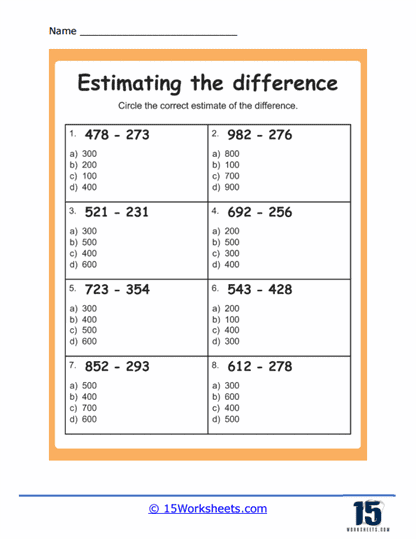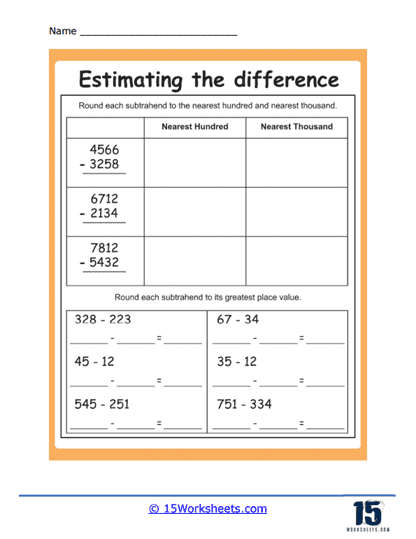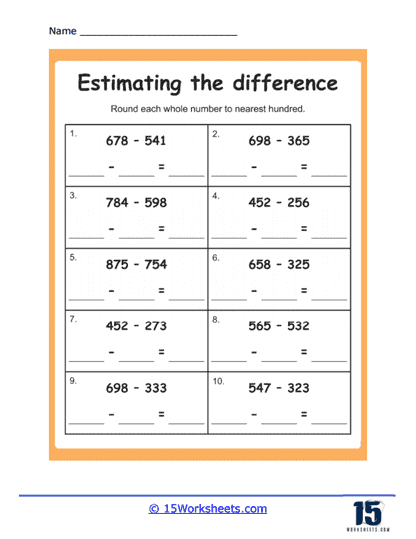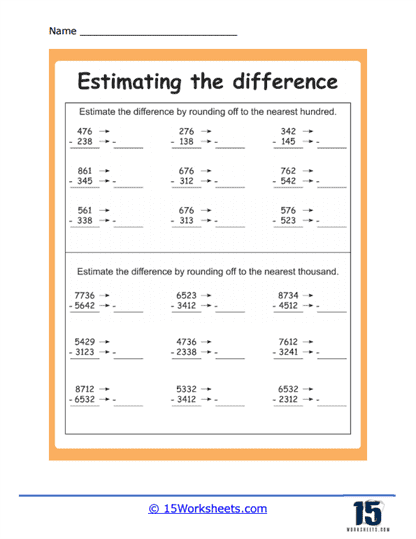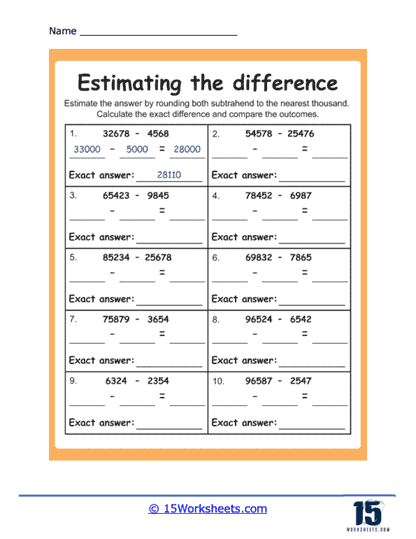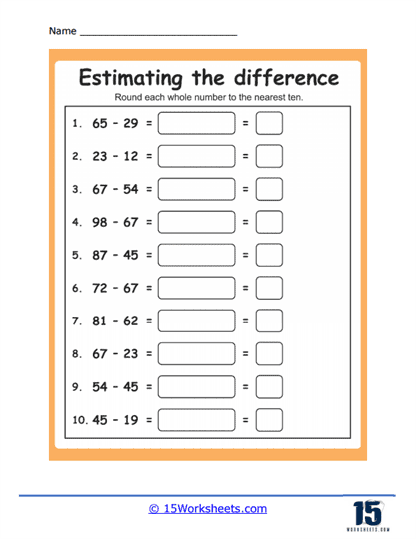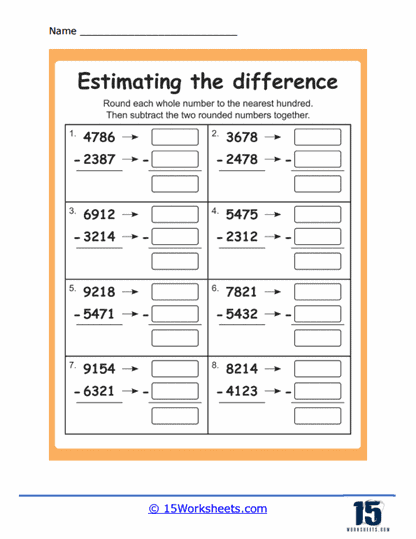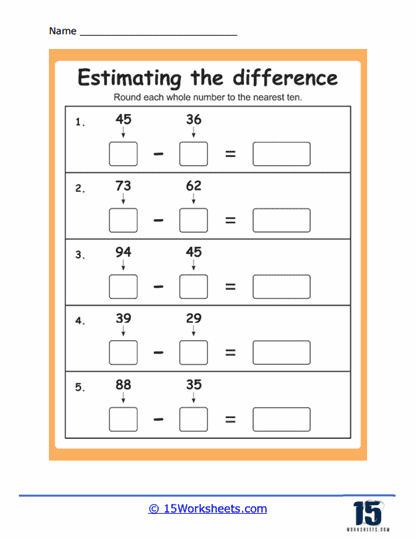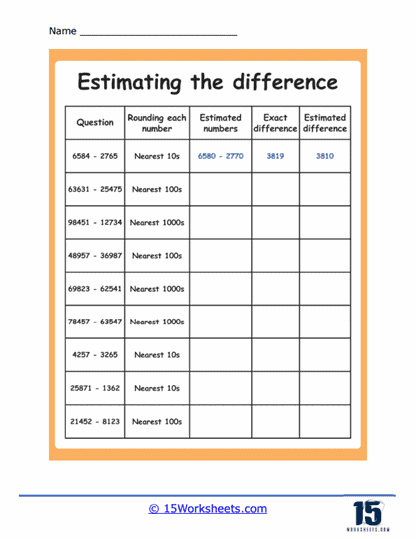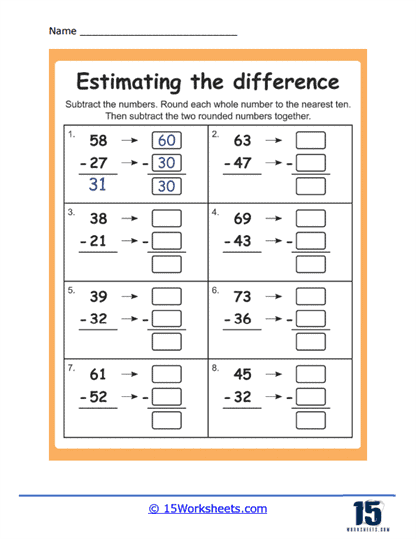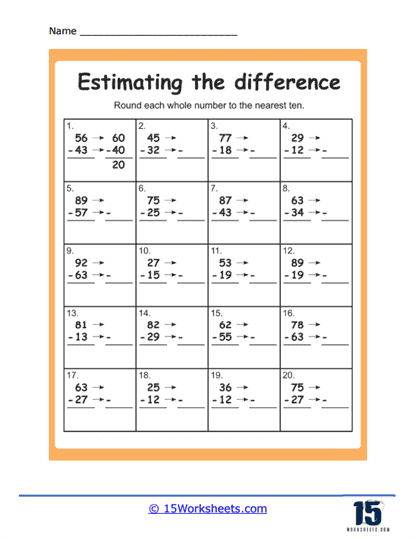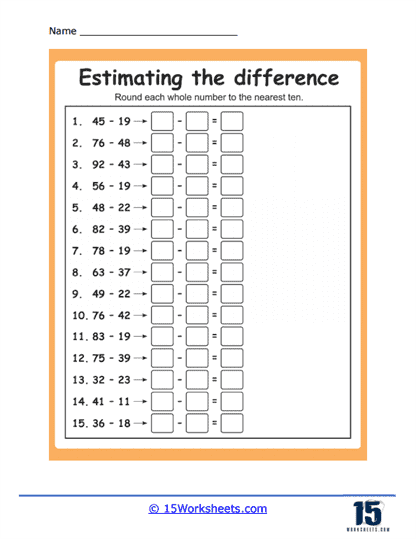Estimating Differences Worksheets
About These 15 Worksheets
The ability to estimate, particularly the difference between numbers, is a key skill that helps us in a variety of everyday situations. For instance, imagine you’re shopping and you only have a certain amount of money. By estimating the total cost of your purchases, you can make sure you stay within your budget. Plus, estimation is a great way to double-check your answers on a math test. If your exact calculation is far from your estimate, you may have made a mistake!
These worksheets include a range of exercises aimed at developing and refining your estimating skills. Here are a few types of exercises you might encounter:
Rounding and Estimating – These exercises teach you how to round numbers to the nearest ten, hundred, or thousand (and so on) before subtracting them. For example, if the question is to estimate the difference between 392 and 167, you might round 392 to 400 and 167 to 170, then subtract to get an estimated difference of 230.
Front-End Estimation – This is where you only consider the leftmost digits (the “front end”) of the numbers you’re subtracting. For example, in 678 – 293, you’d only look at the 600 from 678 and 200 from 293. So, your estimated difference is 400.
Compatible Numbers Estimation – This involves tweaking the numbers slightly to make the subtraction easier and faster. For example, if the problem is 155 – 97, you could adjust 97 to 100, making the estimate 55.
Multi-digit Operations – This involves larger numbers. For example, estimate the difference between 4,568 and 2,897.
By practicing these types of exercises, you will improve your number sense, which is your intuition about numbers and their relationships. This is important for all sorts of math, from basic arithmetic to more advanced algebra and even geometry. Estimating helps you quickly decide whether an answer is reasonable, which can be very helpful in a test situation, or in real life when you’re trying to make a quick decision.
This series really helps you better understand place value, since you have to recognize which digits in a number are most significant when making your estimates. It also strengthens mental math skills, as you’ll often do the rounding and subtraction in your head. Lastly, it fosters problem-solving skills because you need to figure out the best way to estimate for each problem. Sometimes rounding works best; other times, using compatible numbers is easier.
Math can feel intimidating sometimes, especially when you’re dealing with big numbers. But when you can quickly estimate the answer, it makes the problem feel more manageable. Then, when you work out the exact answer and see it’s close to your estimate, you’ll feel a sense of accomplishment and confidence.
How to Estimate Decimal Values
Let’s say you’ve been asked to estimate the difference between 732 and 489.
Step 1) Decide What to Round To
In many cases you will often be told what specific place value to round to. It all depends on how close to the exact value you are expecting to be. The less accurate that you need to be, the higher the place value that you will round to. This makes the make quicker and easier.
Choose whether you’re going to round to the nearest ten, hundred, thousand, and so on. In general, you choose based on the size of the numbers you’re dealing with and how precise you want the estimate to be. For our example, let’s round to the nearest hundred.
Step 2) Round the Numbers
Round each number to the nearest unit you decided on. In this case we are not super concerned about being accurate. We just want a rough idea of the difference, so we will choose to round to the highest place value.
For 732, look at the tens place (3). If this number is 5 or more, round up. If it’s less than 5, round down. So, 732 rounds down to 700.
For 489, the tens place is 8 which is more than 5, so we round up. This makes 489 round up to 500.
Step 3) Subtract the Rounded Numbers
Now, subtract the rounded numbers to find the estimated difference. In our case, 700 (rounded 732) minus 500 (rounded 489) equals 200.
So, by rounding to the nearest hundred and subtracting, we estimate that the difference between 732 and 489 is about 200. This is not the exact answer, but it’s a close approximation that we figured out quickly, which is the goal of estimation.
This Skill In the Real World
Estimating differences is a skill that we use regularly in our everyday lives, sometimes without even realizing it. Let’s look at some common real-world situations and professions where estimating differences is essential:
Shopping on a Budget – Suppose you’re shopping for groceries with a set budget. You pick up items and need to keep a running tally of how much you’ve spent to ensure you stay within your budget. Instead of adding up exact prices (which can be time-consuming and tricky to do in your head), you can round each item’s cost to the nearest dollar (or five dollars, or whatever makes sense) and keep a running total that way.
Cooking and Baking – When you’re following a recipe and you don’t have a specific tool to measure, you need to estimate. You might also adjust a recipe based on the number of people you’re serving, which requires estimating the amounts of the ingredients you need.
Traveling – If you’re planning a road trip, you might need to estimate how much longer it will take to reach your destination or how much more gas you’ll need for the rest of your journey.
Home Improvements – If you’re planning to paint a room or build a piece of furniture, you’ll need to estimate how much paint or how many materials you’ll need.
Estimating differences is also a valuable skill in many professions. Here are a few:
Construction Workers and Engineers – These professionals often have to make quick on-the-spot estimations about material quantities, the time required for certain tasks, or the manpower needed for a project.
Teachers and Educators – They frequently use estimation when grading assignments or managing classroom resources.
Scientists and Researchers – When collecting data or designing experiments, scientists often need to estimate differences. For example, they might estimate how changing one variable will affect the outcome of an experiment.
Finance and Banking Professionals – They regularly estimate differences when creating financial forecasts or budgets, or when analyzing financial data to make investment decisions.
Medical Professionals – Doctors and nurses often have to make quick estimations regarding medication dosages, time between patient appointments, and more.
Chefs and Bakers – In the culinary world, chefs often have to make estimations about food quantities, especially when adjusting a recipe’s size.



